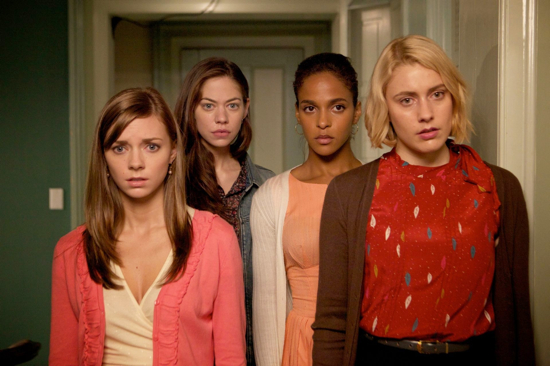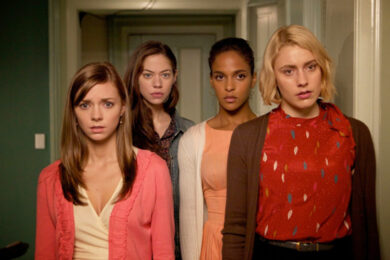Whit Stillman’s impeccably observed movie triptych – Metropolitan (1990), Barcelona (1994), The Last Days Of Disco (1998) – saw him assume the mantle of chief chronicler of the social mores and neuroses of the well-heeled bourgeoisie vacated by a creatively diminished Woody Allen. After the commercial failure of …Disco, Stillman appeared to retreat from public view, moving to Paris and working as a writer for hire on minor projects. Now, after a hiatus which threatened to turn Salingeresque, he’s back with Damsels In Distress, a wilfully idiosyncratic comedy of manners that revels in its whimsical eccentricity – and which is likely to inspire adoration and bemusement in equal measure from audiences.
So much has changed in the 14 years since his last movie, and yet the milieu he depicts here is at once reassuringly familiar to devotees: an Ivy League campus populated by a moneyed, over-educated and often painfully self-aware liberal elite. Whereas the Generation X misfits sought to portray the privileged young as amoral, nihilistic hedonists, Stillman paints them in an altogether more sympathetic light: as upholders of virtue, refinement and traditional values. Small wonder that his films have received such favourable critical notices from right-leaning US publications.
Indie darling Greta Gerwig plays Violet, a self-consciously earnest naïf who recruits new girl Lily (Analeigh Tipton) into her prim clique at Seven Oaks College, and seeks to enlist her help in a well-intentioned if patronising crusade to steer a fratboy-dominated dorm away from the "atmosphere of male barbarism" which pervades and towards the path of self-improvement. Flanked by disciples in virtue Rose (Megalyn Echikunwoke) and Heather (Carrie MacLemore), Violet runs an on-campus Suicide Prevention Center which prescribes a diet of doughnuts and tap dance routines as therapy to its hapless patients. Immune to the forthright criticisms of her anachronistic worldview from the editor of the student paper and the more tactfully expressed reservations of Lily, it’s only when the group dynamic becomes strained by various romantic entanglements that Violet’s delicately constructed house of cards collapses in on itself. Chastened, she seeks spiritual redemption through an unlikely source: the pioneering of a new international dance craze, the Sambola! (exclamation mark obligatory).
Gerwig first rose to prominence as part of the mumblecore movement, a scene characterised by its naturalistic dialogue and emphasis on improvisation, so it was always going to be fascinating to see how she adapted to a director such as Stillman, with his reputation for perfectionism and pedantic adherence to a script. As it happens it’s an inspired match. Impassioned in her wrongheaded convictions, Violet is an irresistible comic creation, a sympathetic and eminently quotable heroine in the classical literary tradition (her take on the myth of Sisyphus is worth the admission fee alone). With her demure countenance and hard-wired notions of integrity, she resembles a younger version of former Stillman leading lady Chloë Sevigny.
The heavily stylised language and deliberate sense of confected reality on display requires an initial adjustment in perception on the part of the viewer, but once you familiarise yourself with the peculiar cadences of the characters’ speech patterns, Damsels In Distress is a droll delight. Stillman’s inimitable knack for wry, irony-layered dialogue ensures virtually every scene is sprinkled with memorable witticisms and one-liners. The humour ranges from the highbrow to the broad, incorporating musings about the plural of doofus ("doofi?" ), slapstick suicide attempts and even a running gag about the sexual practices of the Cathars. While Gerwig steals most of the best lines, there are some fine supporting comic performances, not least from Adam Brody’s Fred: a suave "playboy operator type" who bemoans the decline of homosexuality from "something refined, hidden, sublimated… to muscular morons running around in T-shirts." Parks And Recreation‘s Aubrey Plaza also pops up for a scene-stealing cameo as a deadpan manic depressive.
But if the snappy screenplay gives Damsels… cerebral muscle, it’s the cinematography and music which provides its dazzle. The leafy Seven Oaks campus is captured in exquisite autumnal shades by Doug Emmett, while Ciera Wells’ costumes perfectly compliment the characters’ primary colour exuberance. The diverse array of dance routines, from drunken jiving to Europop to highly choreographed tap sequences, provide some memorable physical comedy interludes amid all the verbose jousting. The closing credits are even accompanied by some helpful instructions on how to master the Sambola!
Damsels In Distress is unlikely to conform to everyone’s tastes. There’s a frivolity and ironic detachment which some might find cloying, while any plot development is so slight as to appear negligible. It’s also, one suspects, going to prove tricky to market beyond a strictly arthouse base, such is the movie’s obtuseness and stubborn defiance of easy categorisation. But for unabashed Stillman enthusiasts (and I count myself among their number) it is a visual and stylistic triumph: an academia-set comedy which channels the best bits of previous genre staples (Heathers, Clueless, Mean Girls), while also subverting the over-familiar tropes sufficiently to feel like a genuine one-off. The climax is at once audacious and disarmingly joyous: a garishly retro dance sequence to George and Ira Gershwin’s ‘Things Are Looking Up’, which pays affectionate homage to the Fred Astaire musical A Damsel In Distress, from which the title originates. With this final major key flourish, Stillman cements the film’s reputation as a cult classic in the making.



